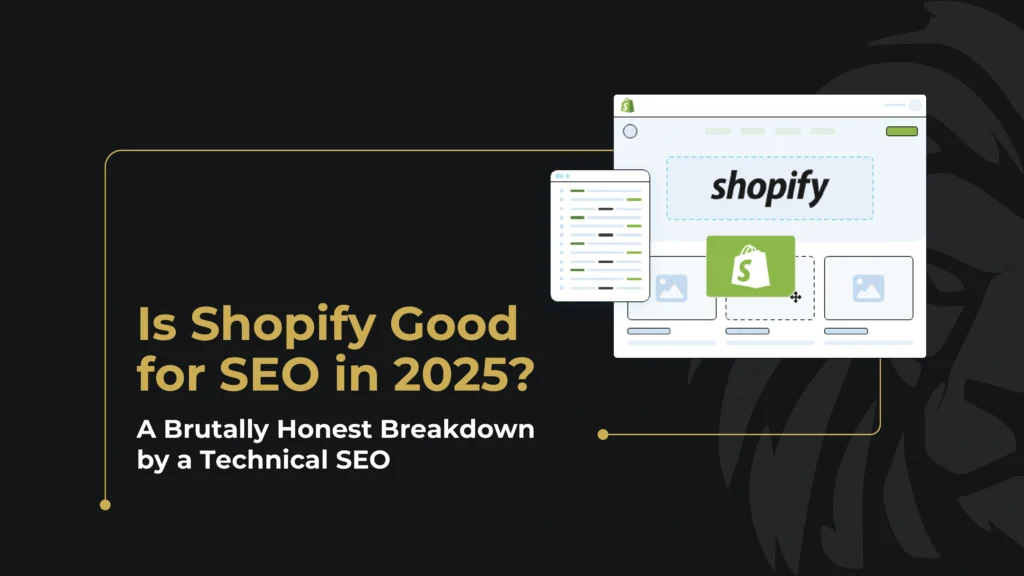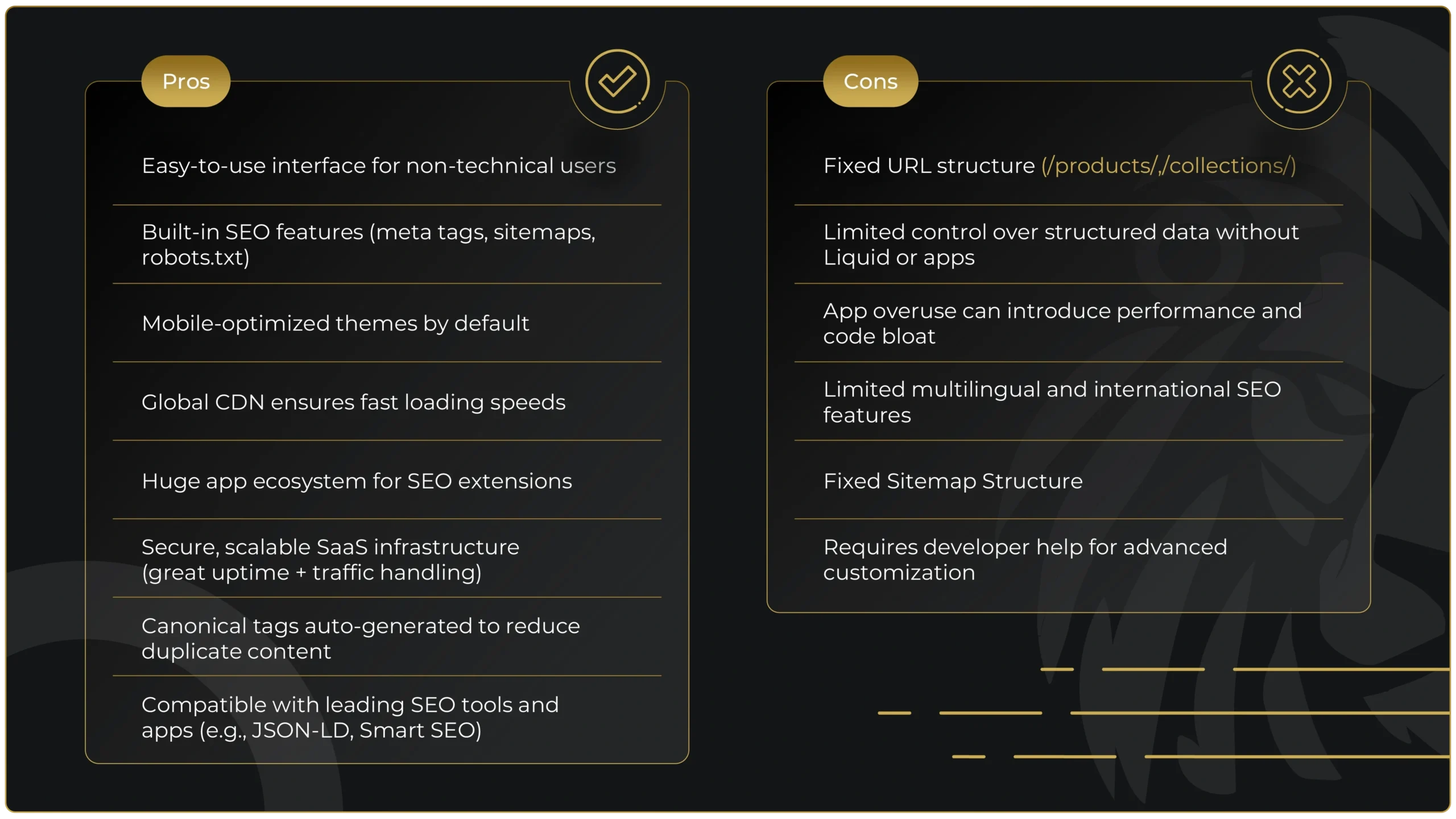Shopify has grown so quickly in the last few years that it is now one of the top e-commerce platforms in the world. As more companies start and grow their online stores, it becomes more and more important to know what Shopify’s SEO strengths and weaknesses are.
Because it has such a large market share, people naturally want to know how well it can rank in Google and other search engines.
The real question isn’t just “can Shopify rank?” The answer to that is yes. Smart business owners and marketers should ask, “What are the best conditions for Shopify to do well in SEO, and who is it best for?”
Google’s AI-generated overview suggests Shopify is generally good for SEO, particularly highlighting user-friendliness, built-in optimisation features, mobile responsiveness, and speed. Yet it also acknowledges that Shopify’s SEO capabilities don’t guarantee high rankings and stresses that success relies heavily on strategic keyword research, content quality, and link building.
This in-depth and technical breakdown will go beyond the AI overview and get into the nitty-gritty of the technical details, the pros and cons of using Shopify in real life, and real-world examples to make it clear when and how Shopify can help you get the SEO results you want.
To maximise your store’s visibility, using the right optimisation tools is key. We’ve reviewed the 6 Best SEO Apps for Your Shopify Store to help you choose the perfect solution for your needs.
TL;DR – What Google AI Overview Says
Google’s AI Overview offers a simplified summary of Shopify’s SEO capabilities, generally presenting it as a beginner-friendly platform with solid foundational features.
Here’s how it breaks down:
What it gets right:
- Ease of use: Shopify’s clean UI and native SEO settings are helpful for beginners.
- Built-in features: It correctly highlights canonical tag creation, automated sitemaps, robots.txt access, and editable meta fields.
- Mobile and speed: Responsive themes and CDN-backed hosting do help improve performance and Core Web Vitals.
What it oversimplifies:
- SEO success depends heavily on execution, not tools alone. Many businesses fail despite “SEO-friendly” platforms.
- “Built-in” SEO does not mean optimised; you often need to change the default settings.
- App usage is mentioned positively but without addressing fragmentation and inconsistency across implementations.
What it misses:
- App reliance: Shopify’s reliance on third-party apps often leads to bloated code, slower load times, and overlapping functions.
- Structured data limitations: Without customisation, Shopify outputs limited or inconsistent schema.
While the AI overview provides a useful overview, SEO professionals and growth-focused teams may find this breakdown to be superficial and not comprehensive enough.
5 Pros of Shopify for SEO
1. User-Friendly Interface
Shopify’s dashboard is intuitive and beginner-friendly, allowing non-technical users to handle basic SEO tasks such as editing meta titles, descriptions, and image alt text.
But GUI-based SEO has its limits; it doesn’t always have the same level of flexibility and scalability as programmatic SEO. You can’t use advanced logic, dynamic internal linking, or batch schema injection without writing your own code or using tools made by other people.
2. Built-in SEO Features
Shopify does offer a solid foundation:
- Automatic generation of canonical tags
- Auto-created XML sitemaps
- Editable meta titles and descriptions per page
- Auto-created Robots/txt file
Still, many of these features need refinement. For example, Shopify often canonicalises product variants to root products, which is useful but sometimes overly aggressive. Theme Liquid files or sophisticated SEO apps are required for merchants to have more precise control.
3. Mobile Optimization
Most Shopify themes are mobile responsive by default, which contributes positively to mobile usability and Core Web Vitals.
That said, many themes rely heavily on JavaScript for rendering page elements. This can delay content visibility and increase Cumulative Layout Shift (CLS), a key performance metric. Developers should audit theme performance regularly.
4. Fast Loading Speeds
Shopify benefits from global CDN hosting and performance-tuned infrastructure. Theoretically, this provides stores with exceptional speed from the start.
However, in practice, third-party app bloat, excessive tracking scripts, and unoptimised images can severely reduce performance. Always audit pages post-launch using tools like Lighthouse and PageSpeed Insights.
5. App Ecosystem
One of Shopify’s strengths is its expansive app marketplace. SEO tools like:
- JSON-LD for SEO (structured data)
- Schema Plus (for enhanced product-rich results)
- Smart SEO (meta templates + multilingual SEO)
These can extend Shopify’s capabilities significantly.
But over-reliance on apps leads to bloated codebases and potential conflicts between plugins. Choose apps carefully and prioritise those that allow server-side or native Liquid integration.
3 Cons and Considerations of Shopify for SEO
1. Not a Magic Bullet
Having a platform with built-in SEO features doesn’t mean automatic rankings. Shopify provides tools, but it doesn’t create strategies.
True SEO success comes from a mix of keyword research, technical auditing, quality content, site structure, and backlink acquisition. Shopify simply lays the groundwork.
2. Requires Real SEO Work
To perform well, merchants must invest in
- Intent-based keyword research
- Strategic content creation (blogs, hubs, PDP/collection SEO)
- Authority building through links
- Semantic optimization via custom collections and internal linking
Shopify doesn’t replace the need for a structured SEO strategy; it just enables parts of it.
3. Limited Customisation
Shopify comes with notable constraints:
- Fixed URL structure (/products/, /collections/) with no routing flexibility
- Structured data output is limited unless manually extended via Liquid or third-party apps
These limitations won’t affect every store, but they matter for enterprise, international, or highly customised SEO setups.
Is Shopify Right for Your Business?
Shopify is a perfect fit for many businesses, but not all. Here’s a quick guide:
Good for:
- Direct-to-consumer (DTC) brands
- Single-country or regional stores
- Entrepreneurs prioritising ease of use and speed-to-market
Not ideal for:
- Multi-language or multi-region sites
- Sites requiring deep URL or routing customization
- SEO-heavy funnels or advanced schema dependencies
Common SEO Pitfalls in Shopify & How to Fix Them
Despite Shopify’s user-friendly design, it presents recurring SEO challenges that, if not properly addressed, can negatively impact visibility. Below are common pitfalls and how to solve them.
Duplicate Content via Variants
By default, Shopify makes separate URLs for each product variant, like size or colour options. It usually canonicalises these back to the parent product, but this doesn’t always work as expected, especially when filters or custom apps are used.
Fix:
Audit variant URLs using Screaming Frog or Ahrefs. Enforce canonical consistency via Liquid templates, or use apps like Smart SEO to control canonical tags dynamically.
Non-Canonical URLs in Filtered Collections
Shopify doesn’t natively canonicalise filtered collection URLs, which can lead to duplicate content or index bloat, especially when filters are crawlable.
Fix:
Disallow unnecessary parameters in robots.txt (where feasible), or apply noindex meta tags for filter combinations. You can also control rendering through Liquid to avoid crawl traps.
Manual Overrides with Liquid or Apps
Shopify doesn’t offer advanced technical SEO controls out of the box, but most problems can be solved through:
- Custom Liquid code in theme.liquid and template files
- Trusted apps like JSON-LD for SEO and Schema Plus
- Strategic use of metafields for custom SEO logic
The key is to audit early, avoid bloated apps, and keep core SEO functions as native as possible.
The Verdict: Can You Rank on Shopify?
Yes, you absolutely can rank on Shopify. But doing so requires manual refinement, strategic SEO work, and technical intervention. Shopify offers a solid baseline with its built-in tools, but they are just that a baseline, not a complete solution.
If you’re relying solely on out-of-the-box settings and default theme configurations, you’ll quickly hit a ceiling. The platform isn’t inherently bad for SEO, far from it. But its default settings ≠ best practices.
To succeed with Shopify SEO in 2025, you need to:
- Understand its structural and technical limits
- Leverage Liquid and custom apps wisely
- Optimize intentionally at every layer, from architecture to content to performance
Shopify rewards the prepared not the passive.
Conclusion
Shopify continues to be one of the most accessible e-commerce platforms, and when configured correctly, it’s absolutely capable of ranking competitively in search.
But let’s be clear: Shopify doesn’t guarantee SEO success; it only enables it. The merchants who see real organic growth are the ones who go beyond the default settings, audit their structures, optimise content workflows, and fix technical SEO pitfalls early.
If you are committed to driving scalable organic traffic with Shopify in 2025, it is advisable to seek more than just generic advice. Get a tailored, technical roadmap for your store.
Request a Shopify SEO Audit or check out our Shopify SEO services to see how we can improve rankings, performance, and conversions with zero fluff.
Shopify SEO FAQs
What are the limitations of Shopify for SEO?
Shopify has several built-in constraints:
- Fixed URL paths (/collections/, /products/) that can’t be customized
- No native server-side rendering (SSR), limiting crawl efficiency
- Limited structured data unless enhanced via Liquid or apps
- robots.txt and sitemap.xml files are only partially configurable
These don’t make SEO impossible, but they do mean you’ll need workarounds or advanced setups.
What are the disadvantages of Shopify?
- Rigid URL structure
- Limited SEO configuration at the code level
- App ecosystem often introduces code bloat and performance issues
- No native support for multilingual SEO or advanced routing
That said, it’s excellent for speed to market and managing a store without deep technical knowledge.
Can Shopify handle high traffic?
Yes. A global content delivery network (CDN) supports Shopify, a cloud-based software as a service (SaaS) platform. It can handle a lot of traffic spikes easily, especially on Shopify Plus. Infrastructure hosting typically poses no issues; the optimisation of performance hinges on the design of your theme and apps.
Can you do SEO on Shopify?
Definitely. Shopify supports:
- Custom title tags and meta descriptions
- Editable image alt text
- Mobile optimization and page speed tuning
- Rich result eligibility via structured data
But to go beyond the basics, you’ll need Liquid coding, a strong content strategy, and third-party SEO tools.
What is the best SEO tool for Shopify?
Top-rated Shopify SEO tools include:
- JSON-LD for SEO: The best for rich snippets and schema
- Smart SEO: Powerful for multilingual and templated meta tags
- Plug In SEO: Great for auditing and basic on-page health
- Ahrefs/Semrush: For keyword tracking and backlink analysis
Choose tools based on your tech skill, store size, and growth targets.

